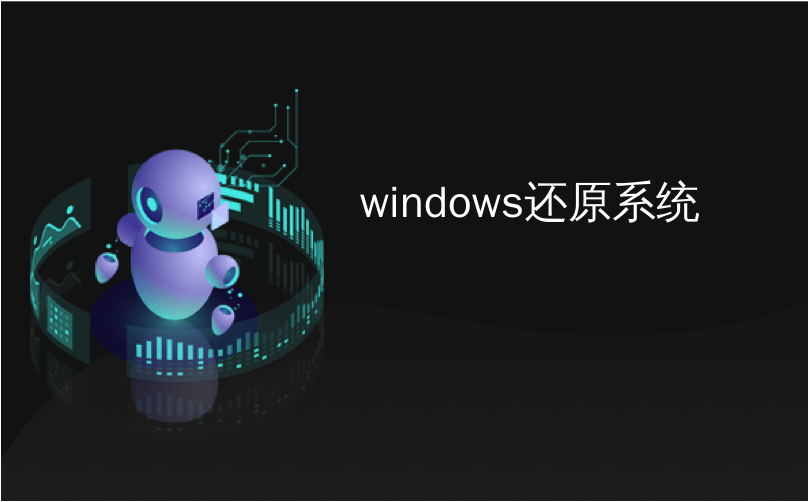
windows还原系统

System Restore is a Windows feature that can help fix certain types of crashes and other computer problems. Here’s how it works, how to set it up, and how to use it when things go awry.
系统还原是Windows的一项功能,可以帮助修复某些类型的崩溃和其他计算机问题。 这是它的工作原理,设置方法以及出现问题时如何使用它。
We’re going to be using Windows 10 in this article, but System Restore has been around a long time–and works pretty much the same way in each version of Windows. The instructions here are good for Windows 7, 8, and 10, and you’ll encounter only minor differences throughout the process.
我们将在本文中使用Windows 10,但是系统还原已经存在了很长时间,并且在每个Windows版本中的工作方式几乎相同。 此处的说明适用于Windows 7、8和10,在整个过程中您只会遇到细微的差异。
什么是系统还原? (What Is System Restore?)
When something goes wrong on your system as a result of a bad piece of software–maybe an app you installed, or a driver that broke something important–it can be hard to fix. System Restore lets you restore your Windows installation back to its last working state.
当由于软件质量问题而导致系统出现问题时(例如您安装的应用程序或损坏了重要内容的驱动程序),可能很难修复。 通过“系统还原”,您可以将Windows安装还原到上一个工作状态。
It does this by creating “restore points” every so often. Restore points are snapshots of your Windows system files, certain program files, registry settings, and hardware drivers. You can create a restore point at any time, though Windows automatically creates a restore point once per week. It also creates a restore point right before a major system event, like installing a new device driver, app, or running Windows update.
为此,它经常创建“还原点”。 还原点是Windows系统文件,某些程序文件,注册表设置和硬件驱动程序的快照。 尽管Windows每周会自动创建一个还原点,但是您可以随时创建一个还原点。 它还在重大系统事件(例如安装新的设备驱动程序,应用程序或运行Windows更新)之前创建还原点。

Then, if something goes wrong, you can run System Restore and point it to a recent restore point. It will reinstate those system settings, files, and drivers, returning your underlying Windows system to that earlier state.
然后,如果出现问题,可以运行“系统还原”并将其指向最近的还原点。 它将恢复这些系统设置,文件和驱动程序,使基础Windows系统恢复到先前的状态。
This can be really useful when troubleshooting certain types of problems. For example, if you install a device driver that makes your computer unstable, you’ll want to uninstall that driver. However, in some cases, the driver may not uninstall properly, or it may damage system files when you uninstall it. If you use System Restore and select a restore point that was created before you installed the driver, this can restore your system files to the previous state before any problem occurred.
在排除某些类型的问题时,这可能非常有用。 例如,如果安装的设备驱动程序使计算机不稳定,则需要卸载该驱动程序。 但是,在某些情况下,驱动程序可能无法正确卸载,或者在卸载时可能会损坏系统文件。 如果使用“系统还原”并选择在安装驱动程序之前创建的还原点,则可以将系统文件还原到以前的状态,然后再出现任何问题。
Windows Restore can also be really useful for undoing the damage caused by a misbehaving app or Windows update. Sometimes, apps and updates can cause problems with other apps or even system components and simply uninstalling the app might not reverse the damage. Restoring to a point before the app was installed, however, can often clear up the problem.
Windows还原对于消除因行为不当的应用程序或Windows更新引起的损坏也非常有用。 有时,应用程序和更新可能会导致其他应用程序甚至系统组件出现问题,仅卸载应用程序可能无法消除损坏。 但是,将其还原到安装该应用程序之前的某个位置通常可以解决问题。
使用系统还原对我的个人文件有何影响? (How Does Using System Restore Affect My Personal Files?)
System Restore is different than making backups–it specifically works on the underlying Windows system, rather than everything on your hard drive. As such, System Restore does not save old copies of your personal files as part of its snapshot. It also will not delete or replace any of your personal files when you perform a restoration. So don’t count on System Restore as working like a backup. That isn’t what it’s intended for. You should always have a good backup procedure in place for all your personal files.
系统还原不同于进行备份-系统还原特别适用于基础Windows系统,而不适用于硬盘驱动器上的所有内容。 因此,系统还原不会将您的个人文件的旧副本保存为快照的一部分。 执行还原时,它也不会删除或替换您的任何个人文件。 因此,不要指望系统还原像备份一样工作。 那不是目的。 您应该始终对所有个人文件都有一个良好的备份过程。
使用系统还原对我的应用程序有何影响? (How Does Using System Restore Affect My Apps?)
When you restore your PC to an earlier restore point, any apps you installed after that point will get uninstalled. Apps that were installed when that restore point was created will still be in place. Apps that you uninstalled after making that restore point will get restored, but with a very big caveat. Since System Restore only restores certain types of files, programs that get restored often won’t work–or at least, work properly until you re-run their installers.
当您将PC还原到较早的还原点时,在该点之后安装的所有应用程序都将被卸载。 创建该还原点时安装的应用程序仍将保留。 还原点之后卸载的应用程序将被还原,但有很大的警告。 由于“系统还原”仅还原某些类型的文件,因此还原的程序通常将无法工作,或者至少在重新运行安装程序之前无法正常工作。
Windows does let you see exactly what programs will be affected when you go through the process, but it’s a good idea to restore to the most recent restore point possible to minimize problems with apps. It’s also a good idea to create manual restore points before you undertake big installations or settings changes so that you know you can revert to a very recent restore point if you need to.
Windows确实可以让您确切地了解整个过程将影响哪些程序,但是最好将还原到可能的最新还原点以最大程度地减少应用程序的问题。 在进行较大的安装或设置更改之前创建手动还原点也是一个好主意,以便您知道可以根据需要还原到最近的还原点。
系统还原可以删除病毒或其他恶意软件吗? (Can System Restore Remove Viruses or Other Malware?)
System Restore is not a good solution for removing viruses or other malware. Since malicious software is typically buried within all kinds of places on a system, you can’t rely on System Restore being able to root out all parts of the malware. Instead, you should rely on a quality virus scanner that you keep up to date.
系统还原不是删除病毒或其他恶意软件的好方法。 由于恶意软件通常埋在系统的各种位置中,因此您不能依靠System Restore根除恶意软件的所有部分。 相反,您应该依靠保持最新状态的高质量病毒扫描程序。
如何启用系统还原 (How to Enable System Restore)
For many people, System Restore protection is turned on by default for your main system drive (C:) and not other drives on your PC. For others, System Restore is not enabled by default for any drives. Right now, there’s no consensus for why this happens. It does not appear related to whether Windows was installed fresh or upgraded, how much disk space you have available, what type of drives you have, or anything else we can figure out.
对于许多人而言,默认情况下,主系统驱动器(C :)而不是PC上的其他驱动器已打开系统还原保护。 对于其他驱动器,默认情况下未为任何驱动器启用系统还原。 目前,为什么会这样还没有共识。 它与Windows是否是全新安装或升级,是否有多少可用磁盘空间,有哪些类型的驱动器或我们能确定的其他内容无关。
If you want to be protected by System Restore, you should absolutely turn it on for at least your system drive. In most cases, that’s all you need, since all the things System Restore protects tend to be located on the system drive anyway. If you want to turn on System Restore protection for other drives–say, for example, you install some programs to a different drive–you can do that too.
如果要通过“系统还原”进行保护,则应至少在系统驱动器上将其绝对打开。 在大多数情况下,这就是您所需要的,因为系统还原保护的所有内容通常都位于系统驱动器上。 如果要为其他驱动器打开“系统还原”保护(例如,将某些程序安装到其他驱动器上),也可以这样做。
To make sure System Restore is turned on–and to enable it for specific drives–hit Start, type “restore,” and then click “Create a restore point.” Don’t worry. This doesn’t actually create a restore point; it just opens the dialog where you can get to all the System Restore options.
要确保已启用“系统还原”(并为特定驱动器启用它),请单击“开始”,键入“ restore”,然后单击“创建还原点”。 不用担心这实际上并没有创建还原点。 它只是打开对话框,您可以在其中找到所有“系统还原”选项。
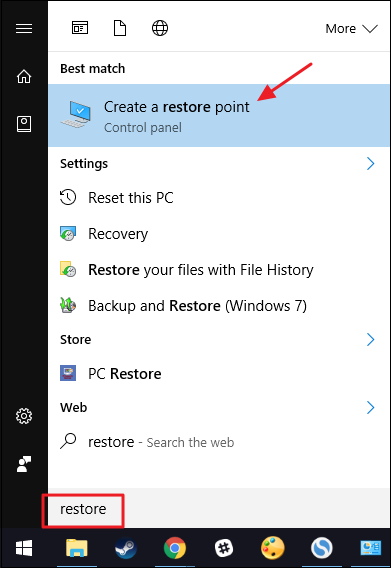
On the “System Protection” tab, in the “Protection Settings” section, you’ll see the available drives on your PC and whether protection is enabled for each drive. To turn on protection, select a drive on the list and click the “Configure” button.
在“系统保护”选项卡上的“保护设置”部分,您将看到PC上的可用驱动器以及是否为每个驱动器启用了保护。 要打开保护,请在列表中选择一个驱动器,然后单击“配置”按钮。
(In our case, System Restore was already enabled for our C: drive. If it isn’t on your system, that’s the first drive you’ll probably want to enable it for.)
(在我们的例子中,已经为我们的C:驱动器启用了系统还原。如果您的系统上没有它,则可能是您要为其启用的第一个驱动器。)
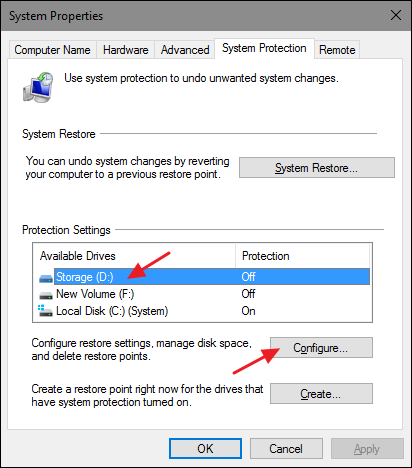
In the “System Protection” dialog that opens, click the “Turn on system protection” option, adjust the “Max Usage” slider to the amount of hard drive space you want System Restore to be able to use, and then click “OK.”
在打开的“系统保护”对话框中,单击“打开系统保护”选项,将“最大使用率”滑块调整为希望系统还原能够使用的硬盘空间,然后单击“确定”。 ”
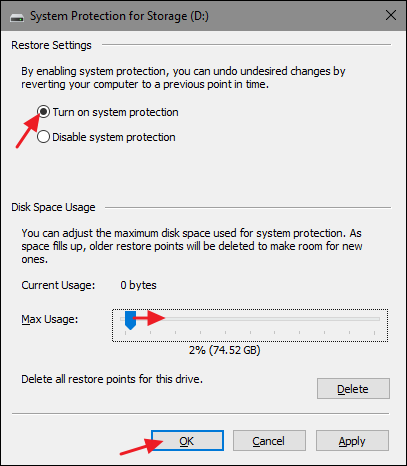
You can then click “OK” again to exit the System Properties dialog. Just be aware that when Windows creates a restore point (or you create one manually), System Restore will create a restore point on all the drives that have system protection enabled.
然后,您可以再次单击“确定”以退出“系统属性”对话框。 请注意,当Windows创建一个还原点(或您手动创建一个还原点)时,“系统还原”将在所有启用了系统保护的驱动器上创建一个还原点。
如何创建还原点 (How to Create a Restore Point)
As we mentioned earlier, System Restore automatically creates restore points on a week, and whenever a major event like an application or driver installation happens. You can also create a restore point yourself whenever you want. Hit Start, type “restore,” and then click “Create a restore point.” On the “System Protection” tab, click the “Create” button.
正如我们前面提到的,“系统还原”会在一周内以及发生诸如应用程序或驱动程序安装之类的重大事件时自动创建还原点。 您还可以随时创建恢复点。 单击“开始”,键入“还原”,然后单击“创建还原点”。 在“系统保护”选项卡上,单击“创建”按钮。
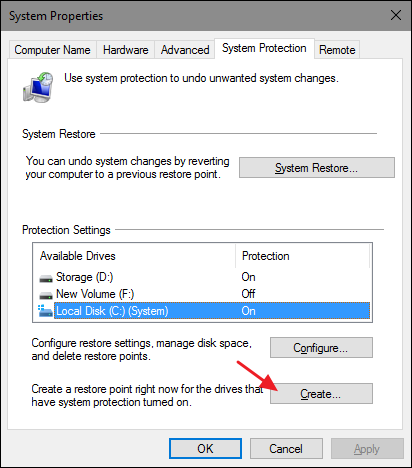
Type a description for your restore point that will help you remember why you created it and then click “Create.”
输入您的还原点说明,以帮助您记住创建该还原点的原因,然后单击“创建”。
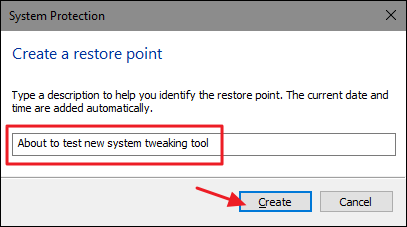
It can take 30 seconds or so to create a restore point, and System Restore will let you know when it’s done. Click “Close.”
创建还原点可能需要30秒钟左右,“系统还原”将在完成时通知您。 点击“关闭”。

如何将系统还原到较早的还原点 (How to Restore Your System to an Earlier Restore Point)
Okay, so you have System Restore enabled, and you’ve been diligent about creating restore points whenever you mess with your system. Then, one fateful day, the inevitable happens–something goes wonky with your system, and you want to restore to an earlier restore point.
好的,因此您已经启用了系统还原,并且一直努力在遇到系统混乱时创建还原点。 然后,命运的一天,不可避免的事情发生了–系统发生了一些不可思议的事情,并且您想要还原到更早的还原点。
You’ll start the restore process from the same “System Protection” tab where you configure System Restore options. Hit Start, type “restore,” and then click “Create a restore point.” On the “System Protection” tab, click the “System Restore” button.
您将从配置系统还原选项的相同“系统保护”选项卡开始还原过程。 单击“开始”,键入“还原”,然后单击“创建还原点”。 在“系统保护”选项卡上,单击“系统还原”按钮。
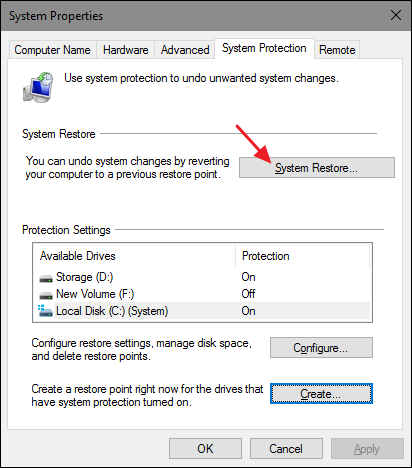
The welcome page of the System Restore wizard just gives you a brief description of the process. Click “Next” to go on.
系统还原向导的欢迎页面仅向您简要介绍该过程。 单击“下一步”继续。
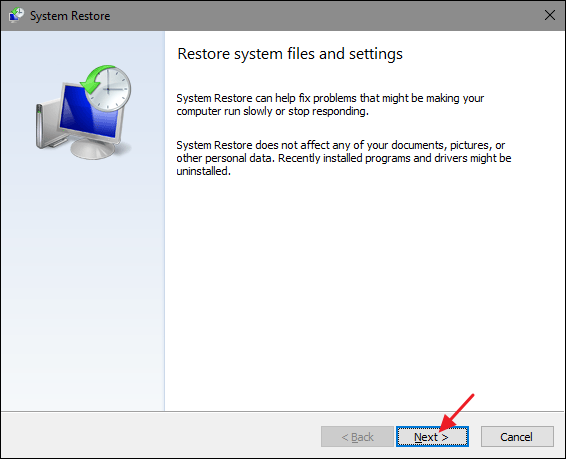
The next page shows you the available restore points. By default, the only thing showing will probably be the automatic weekly restore point and any manual restore points you’ve created. Select the “Show more restore points” option to see any automatic restore points created before app or driver installations.
下一页显示可用的还原点。 默认情况下,唯一显示的内容可能是每周自动还原点和您创建的任何手动还原点。 选择“显示更多还原点”选项,以查看在安装应用程序或驱动程序之前创建的所有自动还原点。
Select the restore point you want–remember, the most recent working restore point is ideal–and then click “Scan for affected programs” to have System Restore detect any programs that will be uninstalled during the process.
选择您想要的还原点(请记住,最近工作的还原点是理想选择),然后单击“扫描受影响的程序”以使系统还原检测到在此过程中将要卸载的任何程序。
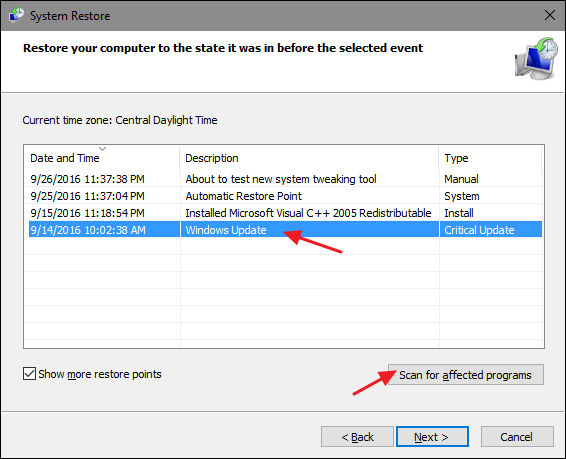
System Restore will present you with two lists. The top list shows you programs and drivers that will be deleted if you restore Windows to the selected restore point. The bottom list shows programs and drivers that might be restored by the process. Again, even programs and drivers that get restored might not function properly until you do a full reinstall.
系统还原将显示两个列表。 顶部列表显示了将Windows还原到所选还原点时将删除的程序和驱动程序。 底部列表显示该进程可能恢复的程序和驱动程序。 同样,即使您进行了完全重新安装,即使要还原的程序和驱动程序也可能无法正常运行。
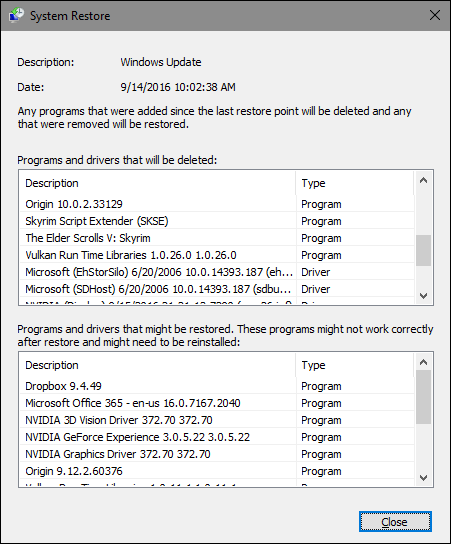
When you’re ready to restore, click the restore point you want to use and then click Next. Note that you can skip the scanning step and just click Next anyway, but it’s always good to see what apps will be affected before you start the process.
准备还原时,请单击要使用的还原点,然后单击“下一步”。 请注意,您可以跳过扫描步骤,无论如何都单击“下一步”,但是在开始此过程之前,先查看一下将影响哪些应用程序始终是一件好事。
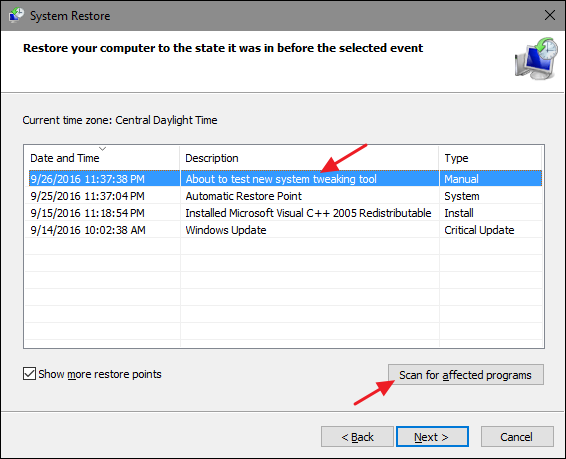
Next, you’re asked to confirm the restoration. Make sure you’ve selected the right restore point and click “Finish.”
接下来,要求您确认还原。 确保选择了正确的还原点,然后单击“完成”。
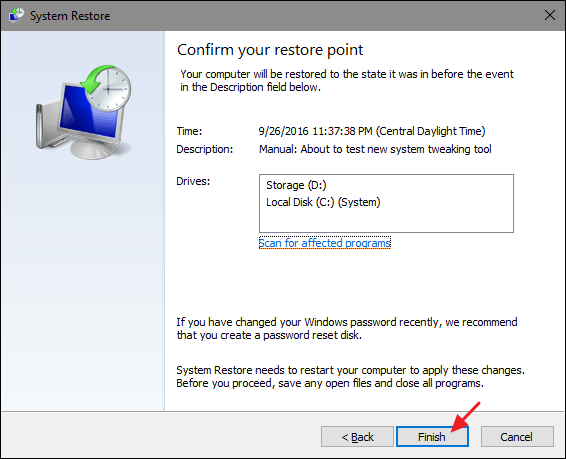
System Restore informs you that once it starts, the restore process cannot be interrupted. Click “Yes” to start.
系统还原通知您,一旦启动,还原过程将不会中断。 单击“是”开始。
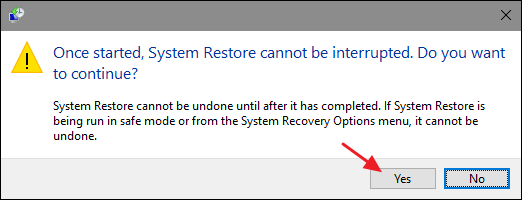
Windows will restart your PC and begin the restore process. It can take a while for System Restore to reinstate all those files–plan for at least 15 minutes, possibly more–but when your PC comes back up, you’ll be running at your selected restore point. It’s now time to test whether it resolved whatever problems you were having. And remember that System Restore creates an additional restore point right before performing the restore process, so you can always undo your actions by performing this same process and selecting that new restore point.
Windows将重新启动PC并开始还原过程。 系统还原可能需要一段时间才能恢复所有这些文件(计划至少15分钟,甚至可能更多),但是当PC恢复启动时,您将在选定的还原点运行。 现在该测试它是否解决了您遇到的任何问题。 请记住,系统还原会在执行还原过程之前立即创建一个附加的还原点,因此您始终可以通过执行相同的过程并选择该新的还原点来撤消操作。
解决系统问题的其他方法 (Other Ways You Can Fix System Problems)
If System Restore doesn’t solve your problem, there are other ways you can go about addressing some of the issues System Restore is designed to solve.
如果“系统还原”无法解决您的问题,则可以采用其他方法来解决“系统还原”旨在解决的某些问题。
If the problem was caused by a recent update, you can look at uninstalling that Windows Update or reverting to a previous “build” of Windows 10. This should fix problems that might occur due to Windows Update and issues with your specific hardware and software.
如果问题是由最近的更新引起的,则可以查看卸载该Windows Update或还原为Windows 10的先前“内部版本”的情况。 这应该解决由于Windows Update以及特定硬件和软件问题而可能发生的问题。
If you believe your system files are corrupted–or just want to check–you can try using the System File Checker to scan for and fix corrupt system files.
如果您认为系统文件已损坏(或只想检查),则可以尝试使用系统文件检查器扫描并修复损坏的系统文件。
If you installed an update or hardware driver and the problem started after that, you can uninstall the driver or update and block them from being automatically installed again.
如果您安装了更新程序或硬件驱动程序,然后又开始出现问题,则可以卸载该驱动程序或进行更新,并阻止它们再次自动安装。
If Windows isn’t booting properly so you can’t do any of this, you can boot into Safe Mode. You can also visit the “advanced startup options” screen — these will automatically appear if Windows 10 can’t boot normally — and use the options there.
如果Windows无法正常启动,那么您将无法执行任何操作,则可以启动到安全模式。 您还可以访问“高级启动选项”屏幕(如果Windows 10无法正常启动,这些屏幕将自动出现),并在那里使用这些选项。
Safe Mode is also useful if for some reason System Restore is unable to restore your PC to the selected restore point. You can boot into Safe Mode and try running System Restore again from there. One big caveat though, as reader Straspey was good enough to point out. When you revert to a restore point from Safe Mode, System Restore does not create a new restore point during the process, meaning that you don’t have a way to undo the restore.
如果出于某种原因系统还原无法将PC还原到所选的还原点,则安全模式也很有用。 您可以启动到安全模式,然后尝试从那里再次运行系统还原。 不过,有一个很大的警告,读者Straspey很好地指出了这一点。 从安全模式还原到还原点时,系统还原不会在此过程中创建新的还原点,这意味着您无法撤消还原。
Windows 10 also has two recovery tools that you can use if all else fails. The “Reset Your PC” feature can restore Windows to its factory default condition, or perform a clean installation of Windows while keeping your personal files intact.
Windows 10还具有两个恢复工具,如果其他所有方法都失败,则可以使用它们。 “重置您的PC ”功能可以将Windows恢复到出厂默认状态,或者在保持个人文件完整的同时执行Windows的全新安装。
System Restore isn’t a cure-all, but it can fix a surprising number of problems and unfortunately has been downplayed somewhat in recent years amidst all of Windows’ other recovery tools. System Restore is almost always worth trying before you result to more drastic measures, though.
系统还原并不是万能的解决方案,但是它可以解决许多令人惊讶的问题,不幸的是,近年来,在所有其他Windows恢复工具中,系统还原被低估了。 不过,在采取更严格的措施之前,几乎总是值得尝试“系统还原”。
翻译自: https://www.howtogeek.com/howto/windows-vista/using-windows-vista-system-restore/
windows还原系统




















 485
485











 被折叠的 条评论
为什么被折叠?
被折叠的 条评论
为什么被折叠?








